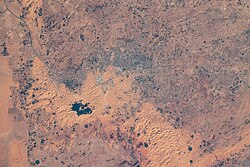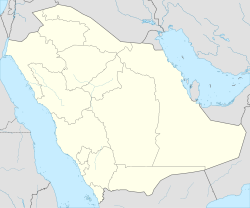Top Qs
Timeline
Chat
Perspective
Sakaka, Saudi Arabia
City in Al-Jouf, Saudi Arabia From Wikipedia, the free encyclopedia
Remove ads
Sakākā, often spelled Sakakah (Arabic: سَكَاكَا) is a city in northwestern Saudi Arabia which is the capital of Al-Jawf Province.[2] It is located just to the north of the An Nafud desert. Sakakah had a population of 204,174 at the 2022 census.[3]
Remove ads
History
This section needs expansion. You can help by adding to it. (June 2025) |
Sakaka is considered one of the oldest inhabited sites within the Arabian peninsula, settled as far back as 4000 years ago.[4]
The city was mentioned in the 8th century - 7th century BCE as an Assyrian civilization's site.
Sakakah is an oasis town on an ancient caravan route across the Arabian peninsula, which ran from the Mediterranean sea coast to the central and southern parts of the Arabian Peninsula.[5]
Remove ads
Modernization
In recent years, the Saudi government has been providing more seed capital to Al-Jawf region, especially in Sakaka in hopes of developing the economically starved region of the kingdom. For this reason, the city has new government buildings, schools and hospitals and are built adjacent to crumbling ruins of older buildings. One major feature of the city is the rapidly expanding Al Jouf University (Jami'at Al-Jawf), founded in 2005.[6] Sakaka is a small but expanding city with much construction in progress. It has three major hospitals: King Abdul Aziz Specialist Hospital, Prince Mutaib Hospital and child and maternity care hospital.[citation needed] There is a newly established Oncology Center and a Cardiac Center.[citation needed] A big ongoing project is the 1,000-bed Prince Muhammed Bin Abdulaziz Medical City which is under construction.[citation needed]
Remove ads
Education
The King hopes that Al Jouf University will become a pillar of social, cultural, and intellectual advancement in Saudi Arabia.[citation needed] There are several government-run schools and some private schools.[citation needed] The city has three English schools, Sakaka International School, which is an international, mostly Egyptian School and has an American curriculum, the other Al-Jouf International school with British curriculum and the third one is Al Motaqadimah International School with American curriculum.
Transportation
The city is served by Al-Jawf Airport which has domestic flights and International flights to some of the major cities in the Middle East. Saudi Arabia Railways also has a station in Sakakah on its Riyadh–Qurayyat line.
Services at Jouf station
Remove ads
Agriculture
Al-Jawf is notable for its abundant agricultural water, making possible the cultivation of dates (200,000 palms) and olives (12,000,000 trees), as well as other agricultural products. Farms number around 16,000, and agricultural projects around 1,500. It is the home to agribusiness farms such as Watania Farms,[7] the largest organic farm in the kingdom. The fertile agricultural land of Al-Jawf is due largely to underground water, which drew delegates of King Abdul Aziz. They were sent to the town of Sakaka and Dumat Al-Jandal and Qurayat, requesting resident tribes there to join the nascent kingdom. Sakaka is home to many Saudi families that can proudly trace their lineage to a few large, old tribes that have dominated the area since time immemorial.
Remove ads
Historical places
- Rajajil standing stones sign Board
- Omar Mosque in Dumat Al-Jandal
- Mard Castle
The history of Al-Jawf dates back more than four thousand years. It is the home of many historic & prehistoric archaeological sites such Za'bal Castle & Well, the Omar ibn Al-Khattab Mosque, located in Dowmat Al-Jandal and Mard Castle (just south of Sakaka). There are also the ancient Rajajil standing stones in Sakaka, dating back nearly 6,000 years.[citation needed]
Remove ads
Climate
Summarize
Perspective
The Köppen-Geiger climate classification system classifies its climate as hot desert (BWh).[8]
Remove ads
See also
References
External links
Wikiwand - on
Seamless Wikipedia browsing. On steroids.
Remove ads





